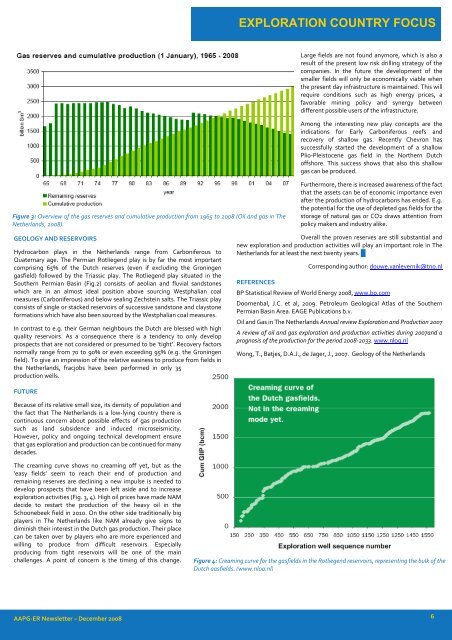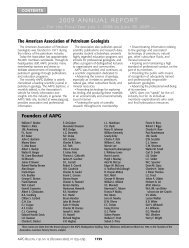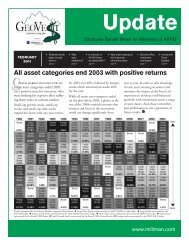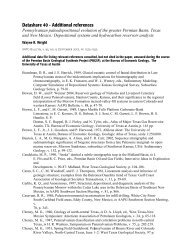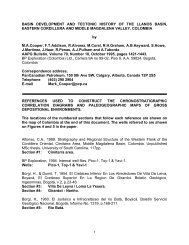president's message - American Association of Petroleum Geologists
president's message - American Association of Petroleum Geologists
president's message - American Association of Petroleum Geologists
Create successful ePaper yourself
Turn your PDF publications into a flip-book with our unique Google optimized e-Paper software.
Figure 3: Overview <strong>of</strong> the gas reserves and cumulative production from 1965 to 2008 (Oil and gas in The<br />
Netherlands, 2008).<br />
GEOLOGY AND RESERVOIRS<br />
Hydrocarbon plays in the Netherlands range from Carboniferous to<br />
Quaternary age. The Permian Rotliegend play is by far the most important<br />
comprising 65% <strong>of</strong> the Dutch reserves (even if excluding the Groningen<br />
gasfield) followed by the Triassic play. The Rotliegend play situated in the<br />
Southern Permian Basin (Fig.2) consists <strong>of</strong> aeolian and fluvial sandstones<br />
which are in an almost ideal position above sourcing Westphalian coal<br />
measures (Carboniferous) and below sealing Zechstein salts. The Triassic play<br />
consists <strong>of</strong> single or stacked reservoirs <strong>of</strong> successive sandstone and claystone<br />
formations which have also been sourced by the Westphalian coal measures.<br />
In contrast to e.g. their German neighbours the Dutch are blessed with high<br />
quality reservoirs. As a consequence there is a tendency to only develop<br />
prospects that are not considered or presumed to be ‘tight’. Recovery factors<br />
normally range from 70 to 90% or even exceeding 95% (e.g. the Groningen<br />
field). To give an impression <strong>of</strong> the relative easiness to produce from fields in<br />
the Netherlands, fracjobs have been performed in only 35<br />
production wells.<br />
FUTURE<br />
Because <strong>of</strong> its relative small size, its density <strong>of</strong> population and<br />
the fact that The Netherlands is a low‐lying country there is<br />
continuous concern about possible effects <strong>of</strong> gas production<br />
such as land subsidence and induced microseismicity.<br />
However, policy and ongoing technical development ensure<br />
that gas exploration and production can be continued for many<br />
decades.<br />
The creaming curve shows no creaming <strong>of</strong>f yet, but as the<br />
‘easy fields’ seem to reach their end <strong>of</strong> production and<br />
remaining reserves are declining a new impulse is needed to<br />
develop prospects that have been left aside and to increase<br />
exploration activities (Fig. 3, 4). High oil prices have made NAM<br />
decide to restart the production <strong>of</strong> the heavy oil in the<br />
Schoonebeek field in 2010. On the other side traditionally big<br />
players in The Netherlands like NAM already give signs to<br />
diminish their interest in the Dutch gas production. Their place<br />
can be taken over by players who are more experienced and<br />
willing to produce from difficult reservoirs. Especially<br />
producing from tight reservoirs will be one <strong>of</strong> the main<br />
challenges. A point <strong>of</strong> concern is the timing <strong>of</strong> this change.<br />
AAPG‐ER Newsletter – December 2008<br />
EXPLORATION COUNTRY FOCUS<br />
Large fields are not found anymore, which is also a<br />
result <strong>of</strong> the present low risk drilling strategy <strong>of</strong> the<br />
companies. In the future the development <strong>of</strong> the<br />
smaller fields will only be economically viable when<br />
the present day infrastructure is maintained. This will<br />
require conditions such as high energy prices, a<br />
favorable mining policy and synergy between<br />
different possible users <strong>of</strong> the infrastructure.<br />
Among the interesting new play concepts are the<br />
indications for Early Carboniferous reefs and<br />
recovery <strong>of</strong> shallow gas. Recently Chevron has<br />
successfully started the development <strong>of</strong> a shallow<br />
Plio‐Pleistocene gas field in the Northern Dutch<br />
<strong>of</strong>fshore. This success shows that also this shallow<br />
gas can be produced.<br />
Furthermore, there is increased awareness <strong>of</strong> the fact<br />
that the assets can be <strong>of</strong> economic importance even<br />
after the production <strong>of</strong> hydrocarbons has ended. E.g.<br />
the potential for the use <strong>of</strong> depleted gas fields for the<br />
storage <strong>of</strong> natural gas or CO2 draws attention from<br />
policy makers and industry alike.<br />
Overall the proven reserves are still substantial and<br />
new exploration and production activities will play an important role in The<br />
Netherlands for at least the next twenty years. █<br />
Corresponding author: douwe.vanlevernik@tno.nl<br />
REFERENCES<br />
BP Statistical Review <strong>of</strong> World Energy 2008, www.bp.com<br />
Doornenbal, J.C. et al, 2009. <strong>Petroleum</strong> Geological Atlas <strong>of</strong> the Southern<br />
Permian Basin Area. EAGE Publications b.v.<br />
Oil and Gas in The Netherlands Annual review Exploration and Production 2007<br />
A review <strong>of</strong> oil and gas exploration and production activities during 2007and a<br />
prognosis <strong>of</strong> the production for the period 2008‐2033. www.nlog.nl<br />
Wong, T., Batjes, D.A.J., de Jager, J., 2007. Geology <strong>of</strong> the Netherlands<br />
Figure 4: Creaming curve for the gasfields in the Rotliegend reservoirs, representing the bulk <strong>of</strong> the<br />
Dutch gasfields. (www.nlog.nl)<br />
6


